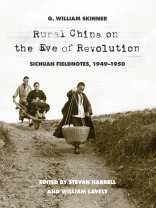In 1949, G. William Skinner, a Cornell University graduate student, set off for southwest China to conduct field research on rural social structure. He settled near the market town of Gaodianzi, Sichuan, and lived there for two and a half months, until the newly arrived Communists asked him to leave. During his time in Sichuan, Skinner kept detailed field notes and took scores of photos of rural life and unfolding events.
Skinner went on to become a giant in his field—his obituary in American Anthropologist called him “the world’s most influential anthropologist of China.” A key portion of his legacy arose from his Sichuan fieldwork, contained in his classic monograph Marketing and Social Structure in Rural China. Although the People’s Liberation Army confiscated Skinner’s research materials, some had been sent out in advance and were discovered among the files donated to the University of Washington Libraries after his death. Skinner’s notes and photos bring to life this rare glimpse of rural China on the brink of momentous change.
Table of Content
Preface / Stevan Harrell and William Lavely
Acknowledgments
Maps
1. The Road to Gaodianzi: June–November 1949
2. Settling In: November 12–26
3. A Household Survey and Rumors of the Communists: November 28–December 16
4. Working Out the Market Network as the PLA Approaches: December 13–24
5. Liberation! December 27–January 3
6. The Communists and the Temples: January 5–13
7. The Last Dongyue Temple Festival: January 15–17
8. The Premature End of Fieldwork: January 18–25
Epilogue: January–May 1950
Afterword / Zhijia Shen
About the author
William Lavely is professor of sociology at the University of Washington. He is a coeditor of Rural China on the Eve of Revolution: Sichuan Fieldnotes, 1949–1950 by G. William Skinner (University of Washington Press, 2016) and the author of many articles on demography and the family in contemporary China.












